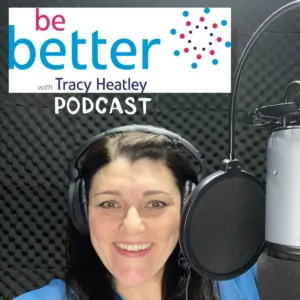This is part one of three parts to help you explore the different marketing mix approaches for your small business. It covers what the marketing mix is and what it means to your small business. It’s full of actionable and easy to apply tips too.
Here is the Small Business Marketing Mix Part One podcast transcript by Tracy Heatley. 
“Hi, I’m Tracy Heatley, welcome to this episode of my Be Better With Tracy Heatley podcast.
Getting Your Marketing Mix Right – The 7p’s Of Marketing. I’m going to break this down over three episodes.
Marketing is not about selling what have. It’s about adapting your product or service to make sure that what you’re offering fills a gap in the market and it’s what your customers require.
To do this, you need to focus on your marketing mix. In the first instance, focus on the 7p’s of marketing. You may or may not have heard of the 7p’s. Namely, product, price, place and promotion, packaging, and positioning. Each of these plays a big part in your marketing strategy.
If you listen to my podcasts regularly, you’ll know that I like to breakdown marketing terminologies, so that you know exactly what they mean to you and your business and that’s what I’m going do now for you with the 7 p’s.
In this episode, we’re going to talk about Product and Price.
Product
This may sound obvious because you know what product or service you provide to your customers. However, there’s much more to it than that, so let me share some of the basic things to consider and apply to your business.
How your product or service functions, in relation to your competitors.
How accessible your product or service is?
What solution does your product provide for your customer?
Who is your product targeted at? What after’s and levels of customer service does your product provide?
These elements will vary depending on your business and your target audience. Also, where you’re positioning your product in the market. One thing is clear, though, to get this right for your business, you must have a clear understanding of your target market. You must know your customer. If haven’t done so already, do some target audience profiling. Remember to be flexible and adapt the way your product or service is offered to suit.
Your product may be about addons or adaptations to your current product or service too. It may mean introducing new products to upsell either through your own business or with strategic alliances with other companies.
Always think about your customer, what they want, what they need and how you can continue to add even more value through your product or service.
Price
Price is a big dilemma for many small business owners, particularly if you’re providing a service. If you’re buying and selling a product, it’s often much easier to assess purchasing price and fixed costs etc. in order to find ideal selling price. For service providers, there many more intangible things to consider. Time, perceived value and sometimes imposter syndrome, which was the focus of a previous podcast episode. Price too high, you may not win the business. Price too low, you may not make enough profit. High price something means things are valued more. Less sales at a higher may mean less operational costs. You may be going for low price with high volume.
You know the ins and outs of your own business. Just know that it plays a big part of your marketing strategy. Your price point can be the tipping of marketing success or failure. Unfortunately, there’s no fixed rule for this. It depends on your business and the market you’re operating in.
Let me share an example with you. When I started working with a former marketing client of mine, the company was pricing low, operating at the low end of the market, which meant they needed to aim for high volume.
This was marketing consultancy client of mine, so I did all their analysis and planning for them. What I discovered was that the marketing was saturated and the lower end of their market. However, there was a massive gap at the top end of the market, so we re-positioned the brand. The cost of materials increased moderately. The product price increased massively. The profit margins were much larger, so the company needed less sales volume to meet its targets. This was a massive change and a risk for this business, but they took my advice and the risk paid off.
My point is that pricing impacts the entire business, not just marketing.
Pricing Strategy Approaches
Here are some potential pricing strategy approaches that may help you and your business:
Basing your pricing on what your competitors charge. This may mean charging a similar price. I may also mean intentionally charging a higher or low price than them.
Purposely pricing low to attract more customers and sell larger volume is another option.
Cost pricing, so that you’re basing on the cost to your business to produce your products and adding chosen mark-up. This will usually be a selected percentage that you know will result in you making a profit.
Charge a premium price because you want what you offer to be perceived as a high-quality product or service. As in, you pay for what you get! Like the Tiffany brand, for example.
Set value-based pricing, which is set according to what your customers are willing to pay. This strategy is largely based on brand perception and the benefits to your customer.
Price Skimming is when you set a high price and then reduce it over time. A good example of this is mobile phones. When a new model comes out, it’s priced high, but reduces over time once all the innovators and early adopters have paid a premium for the latest thing.
Analysis And Planning
Can you see how important it is to do the groundwork of analysis and planning before you set your price and how getting your price right is crucial? It’s always how your customers perceive the value of what you’re offering that counts most. That’s what’s most important with it comes to price. Yes, every business needs to make a profit, but always consider customers perceptions and tolerances when you’re deciding on your pricing point.
If you’re still struggling with this or want to clarify things more specifically in relation to your business, do get in touch with me or book a taster session via my website www.tracyheatley.com.
Speaking of taster sessions, remember that you can be put into my monthly draw to win a free taster session with me. All you have to do is subscribe to this podcast and leave me a review. You can leave reviews on Apple or Audible. If your chosen podcasting platform doesn’t’ have a reviews option, feel free to email me one via the contact page on my website www.tracyheatley.com
I hope you’ve enjoyed this episode and found it useful. I look forward to sharing more elements of the marketing mix and how you can apply it to your business over the next few episodes.
I’m Tracy Heatley. Thank you for listening to my Be Better With Tracy Heatley podcast.
Better Business, Better You!

